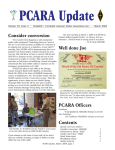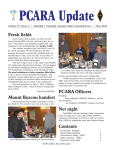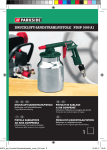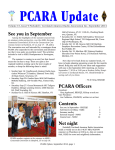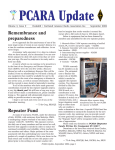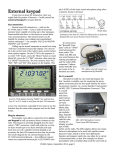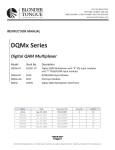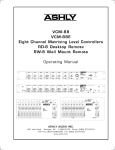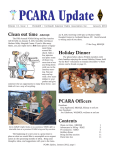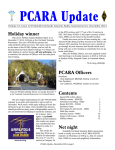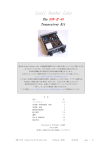Download PCARA Update January 2004
Transcript
PCARA Update Volume 5, Issue 1 Peekskill / Cortlandt Amateur Radio Association Inc. January 2004 New for 2004! Field Day Results There is a change in the line-up of officers for 2004. I would like to take this opportunity to welcome Joe, WA2MCR as the newly elected Vice President of PCARA. On behalf of the membership, I would like to thank Bob, N2CBH for his years of service as PCARA Vice President. Through Bob’s leadership, PCARA was able Joe, WA2MCR at to accomplish many things Field Day 2003. that would not have been possible without it. Bob, Thank you. There has been discussion of PCARA sponsoring a Technician Class Course during ’04. If you would be interested in either teaching or enrolling in the class, please contact Malcolm, NM9J or one of the officers. I would like to wish everyone and their families a very Happy and Healthy New Year. Hope to see you all at Bob, N2CBH at Field the January 4th meeting, we Day. Bob has organized have another busy year to PCARA’s three Field Days plan for! and coordinates PCARA’s – 73 de Greg, KB2CQE three repeaters. December’s QST includes results for Field Day. You’ll remember that the weekend of June 28-29 was very pleasant and PCARA ran up a record score. Here are the results as reported in QST: Peekskill/Cortlandt ARA, W2NYW: This score placed PCARA 201st nationally out of 421 entries in category 2A. Read on for a comparison with our friends in neighboring radio clubs. PCARA was 8th out of 15 in category 2A for the Hudson Division, and 33rd out of 81 entries for all categories in the Hudson Division. The club was 7th out of 22 entries in the ENY Section, behind leader Poughkeepsie ARC, third place Yonkers ARC and fifth place WECA. In fact we were top station (out of three entries) for category 2A in ENY, ahead of PEARL and Schenectady Museum ARA. Full results are in December 2003 QST page 88, or in the online scores database available to ARRL members at http://www.arrl.org/contests/results Kevin N2KZE operating Field Day 2003 with Alan logging. Contents New for 2004, KB2CQE Field Day Results Adventures in DXing, N2KZ Review - Yaesu VX-2, N2CBH Node news The perfect speaker Antenna trials Don’t leave the room QSOs: 733, Power output: 2 (<150W), Participants: 11, total score: 2,328, ARRL section: ENY. 1 1 2 4 4 5 6 7 PCARA Officers President: Greg Appleyard, KB2CQE Vice President: Joe Calabrese, WA2MCR; Secretary/Treasurer: Mike Aiello, N2HTT PCARA Update, January 2004, page 1 kb2cqe @ arrl.net wa2mcr @ arrl.net n2htt @ arrl.net Adventures in DXing -N2KZ It has been a busy month filled with many adventures. A good friend, Lonnie NY2LJ, offered me a trial run of another QRP CW kit he built. This time it was a Small Wonder Labs DSW-II, a miracle designed by Dave Benson, K1SWL. Producing 4 watts of power on 20 meters, it weighs about 12 ounces and can be held in the palm of your hand. It is truly tiny! Small Wonder Labs’ DSW-II QRP single I enjoyed this marvel for a band CW transceiver for 7 or 14 MHz weekend with amazing results. Unlike the Small Wonder Labs RockMite, the DSW-II is continuously tunable. If you push down a mini toggle switch, the unit will send you what frequency you are tuned to in Morse numbers. 14.0300 would read back to you as “3 - 0 - 0.” The tuner also has a useful RIT feature and the ability to tune to WWV time signals broadcast on 15 MHz. The DSW-II has one quirk, which really threw me at first. I turned the rig on and raised what I thought was the audio control wide open. The receiver sounded really hot with many stations apparent up and down the band. I sent CQ to try my luck. I got an instant reply from N1KSN, Andy, in Menasha, Wisconsin. Keep in mind the DSW-II was connected to my 20-meter dipole with no antenna tuner. Bingo! The rig must be working. I had a rewarding and effortless QSO. The DSW-II has a built-in keyer with very smooth QSK. The receiver held Andy’s signal from Wisconsin without any problem. I turned down the volume since he was pounding in. After half an hour or so, we said 73. The band seemed dead as a doornail. In fact, it seemed too dead. The background noise was gone and I heard no stations at all. Did a winter static hit blow out the front end? What’s going on? The answer is simple. The gain control is not for AF. It’s for RF. I don’t think I have ever seen a rig designed like this before. I wish I could talk to Dave, K1SWL, to ask him why he decided to do this. As designed, it is a workable system, but it does take some time to get used to. During periods of severe signal abuse from megawatt short-wave broadcasters you can hear a wisp of their signals leak into the DSW-II’s front end, but you have to really listen for it. Its receive bandwidth is nominally 500 Hz which serves you well for CW operation. Construction of the rig is nearly effortless. There are only four toroids to wind. The unit requires no alignment. Leave your test equipment on your bench! The estimated assembly time is six hours. A 40-meter version is available, as well. The RF output power is adjustable from nearly four watts to nearly zero should “high power” seem like too much luxury or a lack of challenge to you. I ran this rig on 8 AA batteries for hours and hours without any noticeable change in performance. You can use any power source from 8 to 15 volts of DC. The current draw on receive is only 55 milliamps. If you connected this rig to a charged car battery, you could probably operate for years! If I have piqued your curiosity, take a look at http://www.smallwonderlabs.com where the DSW-II manual can be downloaded. The purchase price is $150 direct from Small Wonder Labs. If you are looking for big performance for little dollars, this rig could provide you with many hours of fun. DTV: Looking for adventure at a higher baud rate? Investigate the world of digital television! I have been experimenting with an over-the-air set top box tuner using my array of television antennas to see what programming is available in our area. I feel as if I have jumped back 55 years to the beginnings of television. Only some channels are broadcasting in DT, with some odd surprises. HD programming is only available during very limited hours, mostly in the evening. It’s amazing how this technology still seems like it is in its fetal stages years after its introduction. I managed to pull in nine program streams at my QTH near Goldens Bridge, New York, just south of Brewster off I-684. Here’s a basic digital TV channel guide: 22 - WLIW PBS digital feed and SD Ch. 21 feed 27 - WTBY Trinity Christian Broadcasting Poughkeepsie 33 - WFSB CBS Hartford (analog channel 3) 44 - WNYW “Fox 5” and WWOR “UPN 9” 45 - WABC 52 - WEDW CPTV Connecticut (analog channel 49) 56 - WCBS 57 - WLNY Long Island (analog channel 55) Missing in action were WNBC, WPIX and WNET from New York. I had also heard that WNYE was on the air from Brooklyn with PBS programming. I saw no signal from them, either. One interesting attribute of DTV is the ability to send more than one program stream per carrier. Channel 44 carried both Fox 5 and UPN 9 signals. Using an enormous remote control, you can key in 44-1 or 44-2 PCARA Update, January 2004, page 2 to distinguish between the feeds. WLIW, analog PBS channel 21 from Long Island, also had two feeds on their signal. Channel 22-1 is a continuous feed of PBS Digital programs in HDTV. Channel 22-2 is a digital version of their analog programming. I found the ability to grab signals easy and forgiving. Weak signals would lock in within a wide range of antenna bearing towards the transmitter. Only the weakest signals, like Channel 33 from Hartford, needed to be dead-on to lock them in. The channels are also mapped to the receiver display. Key in 45 for WABC and you will see 7-1 in the display referring to their overthe-air analog signal on Channel 7. If you can see reasonable quality analog TV pictures from New York City with an antenna, especially on the UHF channels, you should be able to lock in digital TV with no problem. Digital TV broadcasts also have the ability to send several versions of captioning (many stations had English and Spanish captions available) and other helpful data such as program titles and length and what type of digital television you are watching. There are currently 18 different “standards” of DTV relating mostly to the level of definition presented. Most common are 1080i (1080 lines interlaced), 720p (720 lines progressive) and 480p (480 lines progressive). 480p is considered the digital equivalent to analog TV quality. There are other sources of digital HDTV that I have not yet experienced. Local cable companies suggest having feeds of HD programming, but I haven’t seen it yet. Keep in mind that over-the-air digital has no connection to what cable companies call “Digital Cable.” Digital cable refers to how the signals are processed and delivered to your home almost always in standard definition. Digital cable is almost always not high definition television. Both DirecTV and Dish Network provide a handful of HDTV via satellite, most notably HD feeds of Showtime, HBO and a HD-only feed called HDNet. HDNet is a feed provided as a demonstration channel with a repetitive schedule of programs from a multitude of sources. Also worth noting is a new service from Rainbow Programming on Long Island called VOOM. This service has no connection to Dr. Seuss and The Cat in the Hat. It is a brand new service catering especially to HD viewers as a single source to receive HD programming, also delivered by satellite. To gain a better understanding of what is being offered in HDTV, take a look at: http:// www.titantv.com/ttv/home/HDTVUpdate.aspx This is a site related to a web service called Titan TV that acts as a HD version of TV Guide. Another site that is a must: http://www.lge.com/experience/yourbetterlife/ digitalTV.jsp Here you will find great inspiration to purchase an HDTV system from Korean manufacturer LG (formerly known as Lucky Goldstar or simply Goldstar.) Read about the life of husband and pregnant wife. A good 30-second giggle is guaranteed! CW: Want to practice code without being on the air? You can now send CW via the Internet using a server in Australia. Download free software for “CW Communicator” at: http://www.mrx.com.au/. Install the application on your computer. Establish an Internet connection. It’s easy to set up for operation. Your down-arrow key on your keyboard is your straight key. You can attach an external key or keyer to a serial port on your computer, if you wish. First, click on the icon that looks like little slidefader volume controls. Go to “Morse Key” and click on “manual,” “keyboard,” and “reset method” and save your settings by clicking “close”. Make sure your computer audio is on. Press the down-arrow key and the box in the upper left hand corner should go white and you should hear your keying. Now you are ready. Next, go to the first icon that looks like a globe. Here you connect to the server. Enter your callsign. Hit “connect” and you will be connected to the server. Unless you enter another virtual channel in the “Morse Key” box, you will default to the calling channel of 1000. After you are connected, click the icon that looks like a computer monitor to reveal all the operators who are communicating on the virtual channels. Go have an Internet CW QSO! I have already worked several hams and non-hams from around the world on this system. There is no QRN, QRM or QSB, but there is sometimes a bit of a lag when Internet traffic is high. It’s a whole new way of sending code, and a great way to practice your abilities before you earn HF privileges. Try it out today! Finally, please note that New Year’s Eve and New Year’s Day is a sacred time for all CW enthusiasts. From 0000 UTC to 2359 UTC January 1, 2004, the ARRL sponsors “Straight Key Night.” SKN is a casual contest encouraging CW operators of all skill levels to get on the air with their straight keys. No bugs, keyers or computers are allowed! This is a wonderful opportunity for testing your CW wings and meeting many, many operators who are usually not on this mode. Contacts can be made on any band within the allocations for your level of license. Listen for many hams sending “CQ SKN” and sending “SKN” instead of K when turning a conversation back to another ham. For more details, please see: http://www.arrl.org/contests/rules/2004/ skn.html Until next month, happy trails from the Old Goat, — N2KZ Karl PCARA Update, January 2004, page 3 Review: Yaesu VX-2 – N2CBH Recently, I tagged along with my wife on a business trip to Las Vegas, Nevada. With not much to do one day I took a stroll over to the local AES store with the idea of picking up a Yaesu VX-2. Many Yaesu products were being offered with a rebate attached until the end of the 2003 so I couldn’t resist. The unit normally sells for $179.00 but with a fifty dollar rebate the price was an irresistible $129.00! I walked back to the hotel where we were staying and opened Yaesu’s new VX-2R the box and immediately charged the lightweight dual battery. Later that afternoon the rig band HT. was ready to try out. The user manual is clear and easy to understand. Yaesu uses a standard type menu driven system for most of their products. If you learn one, you have most of them covered. Basic capabilities include dual band VHF/UHF transceiver with wide band receiving capability from 500 kHz to 1.0 GHz, cellular blocked. This includes wide band reception in the FM broadcast band. Shortwave and AM broadcast band listening are possible but an external antenna is definitely required. The power output is 1.5 watts high power on VHF and 1 watt high power on UHF. The low power setting is 0.5 watts on both bands. The unit utilizes a 1000 mAH lithium ion battery pack which charges quickly in 2.5 hours and has excellent stamina. I was pleased with the battery life to say the least! Rather than tell you everything there is to know about this rig, I would like to focus on some things that impressed me. As I said earlier, the user manual is very straightforward. I usually have some difficulty with a new radio but this one programmed easily the first time with little frustration. In no time I had about 10 or 15 memories filled and had the Yaesu menu system figured out. Once you enter the frequency of interest from the VFO mode you can enter the menu system by pressing one button for one second. The menu has 48 selections. You simply rotate the function switch to the menu item and select those parameters that you want. Once all of the menu items are selected you can program all of these items into a memory location by pressing another button. To me, this is simple and easy to understand. Another thing that impressed me was the small package. This rig is literally the size of a cigarette pack easily fitting into a shirt pocket. Another feature that I think is kind of neat is the ARTS™ function. ARTS stands for Automatic Range Transponder System. ARTS is a system whereby two ARTS equipped radios can tell one another that they are in range of one another. This could be handy for field operations such as rescue or hiking. Another feature that will come in handy for my work is the little known transmitter “channel counter”. The radio has the ability to sniff out transmitting antennas in close proximity and display the transmitted frequency. It does this by applying a 50 dB attenuator to the front end of the receiver so as to only pick up signals in close proximity to the rig’s antenna. This is really a great feature. I must confess that I didn’t know about this feature until I bought the rig! Another confession is that I haven’t tried this feature out yet! The VX-2 like many of Yaesu’s handhelds can be programmed from a PC with additional software and a programming cable. If you are a real scanner junkie or like to program all of the available 900 memories, the software and cable are a must. There are only seven buttons on the front panel of the rig and it doesn’t sport a DTMF keypad, but this doesn’t prevent you from generating DTMF tones. This is done by programming a string of DTMF tones and then accessing one of the DTMF memory banks to execute the string. I would say that this is cumbersome but it probably beats trying to press microscopically small DTMF buttons! There are a lot more features to this rig than an article in a newsletter could possibly hold. I will bring the rig in for the next PCARA meeting for a little show and tell. I can tell you that since I brought this rig home my older Kenwood TH-79 has been gathering dust! — 73 de Bob, N2CBH Node news is good news PCARA members may remember that at the September 2003 meeting we had a successful demonstration of Internet linking. An IRLP link between PCARA’s node 4214 and node number 5220 in Southport, England featured a contact with node owner Mark, G4EID. (By the way your editor has known Mark for many a year from my own time in Southport. Mark was instrumental in introducing me to IRLP during a visit, and in helping to get the PCARA node on the air.) Latest news from Southport is that Mark recently drove 250 miles to Portsmouth in southern England. There he took the U.S. Technician, General, Extra and code tests with an overseas V.E. Team and on December 16 was granted the U.S. Extra class call of AI4DC by the FCC. Mark has requested a 2x1 Vanity call reflecting his own initials. He should get a chance to use that new call for the first time on a visit to the U.S.A. later in 2004. - NM9J PCARA Update, January 2004, page 4 The perfect speaker Occasionally I’ll go on a quest for the perfect something. One recent search was for the perfect loudspeaker. The first thing to realize is that the built-in speaker on any transceiver is a long way from being optimal. How can you Internal speaker from a Yaesu expect good quality from a speaker that is FT-7100 mobile transceiver. Diameter is a mere 1¾ inches and less than 2 inches in 5 diameter and less than depth is only /16 inch. half an inch deep? The second thing to realize is that different circumstances can require different speaker characteristics. HF and Shortwave: You might think that a loudspeaker frequency response of 300 to 3000 Hz would be adequate for an SSB transceiver. But suppose the radio’s general coverage receiver strays out of the amateur bands from time to time onto the high frequency and medium frequency AM broadcast bands. In that case, you’ll probably want something better than “good communications quality”. Those AM broadcast stations transmit plenty of bass frequencies. One approach is to connect a full size hi-fi speaker to the loudspeaker output jack. There is a beneficial side effect as well — if netting one carrier to another or tuning AM signals in SSB mode, the bass response of the speaker will help you adjust for zero-beat. Perhaps you have a portable shortwave receiver with a low-power headphone jack. In that case, try plugging in a pair of amplified computer speakers. The improvement in audio quality can be quite startling. I have had good results with Yamaha YST-M7 amplified speakers and with the Cambridge Soundworks “PCWorks” model that includes a separate subwoofer. If you run into RF-hum problems caused by the speaker power supply, check the following article: http:// home.computer.net/ ~pritch/ shortwav.htm. These Yamaha YST-M7 amplified A good quality computer speakers work well with speaker for AM will a portable shortwave receiver. work equally well on single sideband. The transmitted audio bandwidth on SSB is usually limited to ~300 Hz to 2.8 kHz, so it won’t matter too much if there is some bass cut below 300 Hz. However, a large speaker makes a big difference if you are monitoring the “wideband sideband” signals around 14.178 MHz. You will need a receiver with adequate low-end bandwidth, or you can make use of your transceiver’s “I.F. shift” control to move bass frequencies into the SSB filter’s passband. VHF-UHF FM: You might think that similar considerations would apply to an external speaker for your VHF or UHF FM transceiver. Why not simply plug in a hi-fi loudspeaker and enjoy the high quality that FM can produce? There’s a very good reason why not — and it’s called “PL”. These days, many repeaters carry an ‘encode’ PL or CTCSS tone on the output frequency. PL is sometimes described as a ‘sub-audible’ tone – but the frequencies concerned, from 67 to 250 Hz, are well within the range of normal hearing. If your FM transceiver does not include adequate audio filtering to remove these low frequency tones, you will hear a steady hum coming from the loudspeaker while the repeater is on the air. Use an external speaker with an extended bass response and the effect will be magnified. If you would like a practical demonstration, try listening to our PCARA 146.67 MHz repeater on an Icom IC-706 with a large external speaker. (By the way, W2NYW/R uses an encode tone of 156.7 Hz.) So the first requirement for a VHF/UHF FM speaker is a frequency response that cuts off below 300 Hz. This is fairly easy to arrange – a small diameter speaker and an inadequate baffle will destroy the bass response in no time. However, if you will be using the radio under mobile conditions, a tiny, inefficient speaker is not such a good idea – your aim is to convert as much of the radio’s undistorted audio output to acoustic energy as possible without driving the speaker into distortion. If you have a noisy vehicle, the louder the better! There are plenty of mobile speakers available including branded models from Icom and Kenwood – but I’ve had the most success with products from business radio manufacturers such as Pye and Motorola. They know how to make rugged products that will stand up to years of abuse in the harsh Motorola model contains a large, environment of a heavy loudspeaker for mobile use. motor vehicle. You will probably need to cut off the original connector and substitute a standard amateur radio 1/8 inch mono phone plug to fit the transceiver’s external speaker jack. - 73 de Malcolm, NM9J PCARA Update, January 2004, page 5 Antenna trials – NM9J Antennas can be a trial — especially when things go wrong high in the air. Here’s how things went wrong twice one fine December day. My neighbor, Joe WA2MCR had asked for some help with his Windom. There was snow on the ground and Joe’s yard was still soggy but we braved the winter weather and set forth to investigate the problem. Joe’s yard is surrounded by tall trees and two of the tallest were supporting a “Carolina Windom 160 Special”. Joe had been experiencing problems loading up his transceiver/ATU into this antenna, so it was time for a closer look. Radio Works’ Carolina Windom for 80-10 meters Radio Works’ (http://www.radioworks.com) Carolina Windom consists of a 133 foot dipole fed with coax – not in the middle – but 51 feet from one end. According to the ARRL Antenna Book, this off-center feed results in unequal currents flowing in the dipole sections, and as a result, the vertical feeder may also radiate. Radio Works makes a virtue of this vertical component. They include a “dedicated matching unit” at the feed point to match the coax feed line to the antenna and to “enhance transmission line radiation”. (This “DMU” is probably a 4:1 or 6:1 transformer.) Twenty two feet below the DMU is a “Line Isolator”, which provides “a large inductive reactance at the Radio Works Carolina Windom viewed from below. The Line Isolator is nearest to the camera. insertion point” to eliminate transmission line radiation beyond the point where it is inserted. Radio Works describes the overall design as an inverted-vertical antenna located high in the air. Joe’s “160 Special” version of the Carolina Windom has an “improved DMU and line isolator” to allow use on 160 meters, as well as 80-10 meters. The first thing we The Carolina Windom’s checked was overall perfordedicated matching unit mance. I connected my MFJseemed in good shape... 259 antenna analyzer at the end of the antenna’s coaxial feeder and made a note of each resonant frequency — wherever there was a distinct dip in the SWR. Joe was not very satisfied with the results, so we lowered the antenna and examined the connections. The “dedicated matching unit” seemed to be in good shape, but the “line isolator” was less encouraging. First of all, its coaxial connector was loose, then we saw water dripping from the plastic enclosure. Inspection of the top of the ...but the line isolator had something isolator — wrong inside... where the vertical coaxial feeder enters — showed a far from perfect seal. The plastic enclosures consist of lengths of PVC pipe, sealed off with end caps. Unfortunately, Radio Works seemed to have secured the end caps with PVC cement and removing them would have required destruction with a hacksaw — so we coiled up the antenna and Joe took it indoors to dry out. Later I checked on Google and found five other people who had experienced problems with water entering their Carolina Windoms and spoiling the performance. (More attention needs to be paid to waterproofing the sections of plastic pipe — one approach might be to Joe shows where water had entered the top of the line isolator. fill the internal space PCARA Update, January 2004, page 6 with hot wax or epoxy — though this would increase the weight. An even better approach might be to adopt a design that eliminates the heavy DMU and line isolator altogether.) Joe decided to put his previous G5RV antenna back up as a temporary measure. It did not take long to attach the wire ends to the existing halyards and haul it into place. I connected the MFJ-259 antenna analyzer – and found that disaster had struck. There were no dips at all in the SWR readings, and connecting the antenna to Joe’s transceiver gave poor loading and indifferent reception. G5RV antenna for 80-10 meters as used by Joe, WA2MCR. Once again we went outside to inspect the antenna. Joe’s commercial G5RV has a current choke between the coaxial feeder and the twin feeder that runs up to the center of the dipole. The center insulator was in good shape, but the current choke, mounted once again inside a length of plastic pipe, looked rather doubtful with only three screws holding the SO-239 connector to the base. We disassembled the plastic pipe and found that the outer conductor of the coaxial cable was no longer connected to the SO-239. The bolt that should have completed the circuit had simply sheared off. It did not take too long to replace the broken hardware and hoist Joe’s Current choke on Joe’s G5RV antenna. G5RV antenna back into place. Walking back into the radio room, we heard the welcome sound of CHU-Canada booming out of the receiver on 3330 kHz – and a quick check with the MFJ-259 showed that the antenna was now resonant in or near the usual amateur bands from 80 to 10 meters. Joe was happy when his TS-530 transceiver and MFJ antenna tuning unit loaded up satisfactorily. He later reported that the G5RV was performing in a similar manner to the Carolina Windom, but with less pickup of noise — probably because of the reduced vertical component from this fully balanced antenna. Conclusions: With antennas, it seems that simpler is better. The more complicated hardware you have outside, the more there is to go wrong. Joe’s experience shows that dipole antennas suspended between tree limbs can experience a lot of strain and need to be checked from time to time. Incidentally, Joe uses a system of water-filled bottles as counterweights to maintain steady tension in the antenna halyards while the tree branches are moving around in the wind. A second conclusion concerns the modern practice of enclosing baluns and chokes in sections of plastic water pipe — this may not be ideal for wire dipole antennas. The PVC pipe is heavy, solvent-welded pipe fittings cannot be removed easily and the overall assembly can become waterlogged if there are any holes in the top or sides. The G5RV antenna, with its balanced dipole and lightweight twin lead for the first 30 feet, seems to be a better mechanical design than the Carolina Windom... but perhaps the Windom is a superior multiband antenna to the G5RV? It’s hard to say, but if you want to read further, take a look at W4RNL’s series of articles (9, 10, 11) on “Off-Center-Fed Dipoles” at http:// www.cebik.com/gup/groundup.html. - Malcolm, NM9J Don’t leave the room! PCARA meeting “At the Reef” restaurant, December 7, 2003, when Joe WA2MCR was elected to the post of Vice President. PCARA Update, January 2004, page 7 Peekskill / Cortlandt Amateur Radio Association PCARA Calendar Sunday Jan 4: January meeting, HVHC, 3:00 P.M. Mail: PCARA, PO Box 146, Crompond, NY 10517 E-Mail: [email protected] Web site: http://www.pcara.org Sun Jan 18: ARRL New York/Long Island Section Convention, Long Island Mobile ARC, East Woods School in Oyster Bay, Long Island. Sun Feb 29: LIMARC Long Island Hamfair, Levittown Hall, 201 Levittown Pkwy, Hicksville, NY. 9:00 am. PCARA Update Editor: Malcolm Pritchard, NM9J E-mail: NM9J @ arrl.net Newsletter contributions are always very welcome! PCARA Information PCARA is a Non-Profit Community Service Organization. PCARA meetings take place the first Sunday of each month at 3:00 p.m. in Dining Room B of the Hudson Valley Hospital Center, Route 202, Cortlandt Manor, NY 10567. Drive round behind the main hospital building and enter from the rear (look for the oxygen tanks). Talk-in is available on the 146.67 repeater. Hamfests VE Test Sessions Jan 4: Yonkers ARC, Yonkers Police Dept., 1st Precinct, E Grassy Sprn Rd, 8:30 A.M. Contact: D. Calabrese, 914 667-0587. Jan 12: Split Rock ARA, Hopatcong High School, Rm C-1, Hopatcong NJ. 7:00 p.m. Contact Sid Markowitz, 973 724-2378. Jan 23: Bergen ARA, Westwood Regional HS, 701 Ridgewood Rd, Washington Township NJ. 7:00 P.M. Contact Donald Younger 201 265-6583. Jan 26: Columbia Univ ARC, Watson Labs, 612 W 115th St. New York, NY, 6:30 p.m. Contact Alan Crosswell, 212 854-3754. Feb 1: Yonkers ARC, Yonkers Police Dept., 1st Precinct, E Grassy Sprn Rd, 8:30 A.M. Contact: D. Calabrese, 914 667-0587. PCARA Repeaters W2NYW: 146.67 MHz -0.6, PL 156.7Hz KB2CQE: 449.925MHz -5.0, PL 179.9Hz (IRLP node: 4214) N2CBH: 448.725MHz -5.0, PL 107.2Hz Peekskill / Cortlandt Amateur Radio Association Inc. PO Box 146 Crompond, NY 10517 PCARA Update, January 2004, page 8








